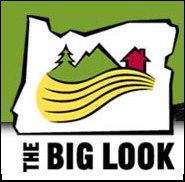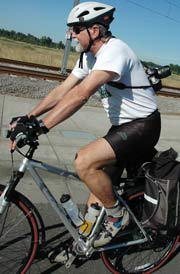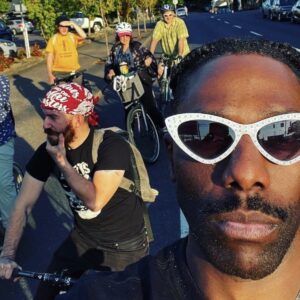
effort to review statewide
land-use planning laws.
Oregon’s Big Look Task Force was appointed by the governor and legislature in 2005 with a mission to review Oregon’s statewide land-use program. A major part of that group’s effort is to travel the state and hear testimony from Oregonians on how our state should grow.
Oregon’s strict land-use laws are generally lauded for encouraging compact growth and preserving rural areas from sprawl.
“In my opinion, this is perhaps the most important event for bicyclists in Portland to attend this year if we want to ensure a bike-friendly future.”
— Reed College student Joel Batterman on tonight’s Big Look town hall meeting
Tonight in Portland, the Big Look Task Force holds their second of ten Town Hall Meetings to garner feedback that will help them shape the recommendations they will present to the Oregon Legislature in 2009.
Joel Batterman is a junior at Reed College and a member of Greenboard, the student environmental group. He has also worked as an intern for 1000 Friends of Oregon (a non-profit land-use planning watchdog) where he wrote a report on the connection between land-use, transportation, and climate change.
Batterman says tonight’s meeting is “perhaps the most important event for bicyclists in Portland to attend this year if we want to ensure a bike-friendly future.” In an email informing me about The Big Look, he wrote:
“Bike-specific infrastructure is great, but for biking to be practical, you need more than just bike lanes. You could outfit a sprawling city like Las Vegas with Copenhagen-class bike infrastructure, and you still wouldn’t see too much biking, simply because places are too far apart… For bicycling to be practical as a means of everyday transportation, you need destinations to be reasonably close together.”
Batterman says some of the proposals being considered by the Big Look Task Force would weaken Oregon’s land-use planning laws. He feels those laws are a key part of why Portland has developed into such a livable city where residents have transportation choices and he wants more people who care about bicycling to make their voices heard.

(Photo © J. Maus)
Mike Houck, Executive Director of the Urban Greenspaces Institute, says that,
“While it may not be readily apparent to the cycling community why the Big Looks is a very big deal, what the Big Look Task Force recommends will directly effect your quality of life.”
Houck wants an improved planning program to,
“ensure that urbanites be no more than a fifteen minute walk from parks and trail networks that provide cyclists and pedestrians both recreational opportunities and an alternative to driving.”
What do you want? How do you think Portland and other Oregon cities should grow?
Learn more about The Big Look and offer your opinions at the Town Hall Meeting tonight in North Portland and check out OregonBigLook.org.






Thanks for reading.
BikePortland has served this community with independent community journalism since 2005. We rely on subscriptions from readers like you to survive. Your financial support is vital in keeping this valuable resource alive and well.
Please subscribe today to strengthen and expand our work.
What do I want? I was born in the midwest in the mid-50\’s, when the most kids ever came into this world. Growing up, I could ride my bike anywhere (it was our only form of transportation until Dad got home from work with our only car). People HAD to watch out for kids riding bikes, because there were more of US than adults!
I want my pre-teen kids to have that opportunity. To ride where ever they want – or need – to, with the same modicum of safety. I want my kids to safely ride to tae kwan do classes, and piano lessons, and baseball practice, and to their friend\’s house 3 miles from our house. Yea, maybe mom or I would tag along to fend off the child molesters. But I want my kids to mount their bikes, and not fear riding along Cornell Road, or NW 206th, or across the Sunset Hiway on 185th up to West Union in Washington County.
Today, my kids cannot make those rides. Well, they could . . . but it just isn\’t safe enough.
That\’s the main thing that I want.
\”hear testimony from Oregonians on how our state should grow\”
How about *IF* it should grow – that rarely if ever makes it into the discussion.
I need to see if I can make this meeting and interject some inconvenient sanity that the legislature isn\’t going to particularly want to hear.
Traffic calming measures like they have in European cities are foremost in my mind lately. Not only does it tangibly encourage cyclists, it also sends a message to motorists that driving everywhere is Really Not Okay.
\”You could outfit a sprawling city like Las Vegas with Copenhagen-class bike infrastructure, and you still wouldn’t see too much biking, simply because places are too far apart…\”
this is probably the biggest issue facing the bicycle\’s successful acceptance to american cities. How can we restructure our sprawling cities to make biking an actual choice? this where our choices (back when) to rely on cheap gas led us astray… our infrastructure is whacked! Now not only do we have to pay for expensive fuels, we have to pay to re-engineer our cities.
Add in the fact that sprawl brings other costs (extending utilities, sewers, etc) that leave cities with less money for efficient infrastructure like bike paths, separated bikeways, etc. Portland\’s visionary growth boundary laws may be the biggest single reason we have a head start on bike-friendliness, and we need to keep the pressure on.
I would love to see cars limited to freeways and expressways. The major streets could be converted to expressways and people would be able to drive within a few blocks of wherever they needed to go, but would then need to walk. The rest of the streets would just have bikes, buses (sorry, there will have to be an option for the disabled, sick, pregnant, etc.) and delivery trucks (have to get stuff to the stores somehow). No one would walk 3 blocks to get to their car so they can go to the store that is 5 blocks away. I know for a fact that this vision is many, MANY years away, but I think it would make for a nice, clean city.
Even though you guys protest that separate facilities just enables bad behavior from drivers, I have to say that there are a large number of potential bike commuters who will NEVER commute until there are separate facilities. I personally don\’t give a crap how careful me and the car are being, there is always potential for the 2 ton hunk of metal to collide with the 150 exposed pounds of me on my bike and guess who loses? It will never feel safe to me to ride in traffic with cars (maybe if they invent clothing with airbags!). I think this is a RATIONAL fear shared by many and it could be argued that those of you who enjoy it might be the ones who are a little bit cuckoo.=) I will bike around my neighborhood where there is only occasional traffic, but I avoid busy streets or anywhere that I have to be riding next to 2 ton hunks of metal for any length of time. However, I (and others like me) would ride my little heart out if we had the scenario in my first paragraph.
I also think people should be encouraged to live in denser housing. Maybe there could be a suggested maximum square footage of 400 per person and people who stay under that would get nice tax breaks. We definitely need to move UP, not out. Put a moratorium on building on \”virgin\” land and clean up some more of the brownfields (or whatever they are called). Put in more condos, and high rises. If you buy a second home, it had better be a rental or you should pay extra taxes on it. I\’m all for the end of the American Dream. The new American Dream needs to be about making sure that there is still nature to see, for everyone, not just the rich who can afford it.
As far as people not biking because things are too far apart. I would say the majority of anyone\’s trips in a given week are to places within a few miles of their home. Traveling across town is more of a once or twice a week thing. It seems like planning should include making sure that nobody HAS to travel more than a few miles to the store, even better a few blocks. I think newer planned communities keep this in mind.
The Big Look Town Hall at UP tonight was an incredibly, depressingly broken event.
They had no signage pointing people to the correct building on campus or the correct room in that building.
They failed to hold citizen comments to reasonable time limit.
They asked loaded questions that left vocal audience members yelling, \”How do I vote none of the above\”.
And worst of all they planned only one event for the entire Portland metropolitan area and the rest of the major cities in the Willamette Valley.
We stayed all the way to the end as they rushed through the second (livable communities) and third (participation and communication) having let measure 47 and measure 39 commentary rule the first a hour-and-a-half of the event.
Supposedly it was meant to generate genuine community brainstorming on guide topics, but instead it was simply rural land-owners venting about the property rights.
It was an abject failure. It was a PR event. It presented the exact same information, videos, and survey offered on the website.
And worst of all, it was the only one of the ten town halls that the urban and suburban population will be likely to participate in.
Instead of making me hopeful about Oregon\’s future and encourage me to build bridges (metaphorical not the CRC) with my fellow Oregonians, it made me fearful of a looming disaster in land-use planning that will permanently damage the successes of the the last thirty years.
Thanks Snowflake, for your summary of the Big Look townhall at UP. I suppose it isn\’t surprising that everyone there could have such a hard time finding common ground. Land use: what to develop, and what not to develop, yet still be able to make a living…is a big issue.
People living in or near big cities find they\’re running out of open, natural land, so naturally, they\’re adverse to seeing any more of it than necessary eaten up by more development. People living far outside big cities have many square miles of undeveloped land, but not enough means to support themselves; understandably, they\’d like development.
I want rural people to be able to make a living out in Oregon\’s beautiful country beyond the metropolis. I just don\’t want Oregon\’s beautiful country spoiled by metropolitan sprawl in order for them to do that.
Snowflake, it wasn\’t all depressing, there was the guy that pointed out that he was growing vegetables on his land, and making a ton of money at it.
But, yes, there were a lot of people that made investments in rural land many years ago, and felt like the state should help them make more money on those investments, (since I highly doubt that any of them has actually lost money on the land, just not made as much as they wanted,) by making life a little bit worse for everyone else. Meanwhile, I\’ve invested my money in the stock market, and I\’ve lost about 15% in the last 9 months, and I\’m not going to meetings asking for a bailout, (although, I\’ve noticed that the fed seems fairly intent on bailing out companies like AIG, by running up the national debt, which makes life a little worse for all of us…. (Hummm, maybe I see where people get their ideas…))
@Matthew Denton
Your right, there were a few bright spots in the public comments. For example, the man that owns several acres at the boundry of Washington and Multnomah counties just outside the Urban Growth Boundry (UGB) who sub-leased parcels of his property to organic farmers that live inside the UGB nearby.
Still, that only pointed to a method that other land owners could use to make there acreage profitable if they are willing to farm it (as zoned). It was more a counter point to the measuer 37 / 49 folks who ate up 80% of the time last night.